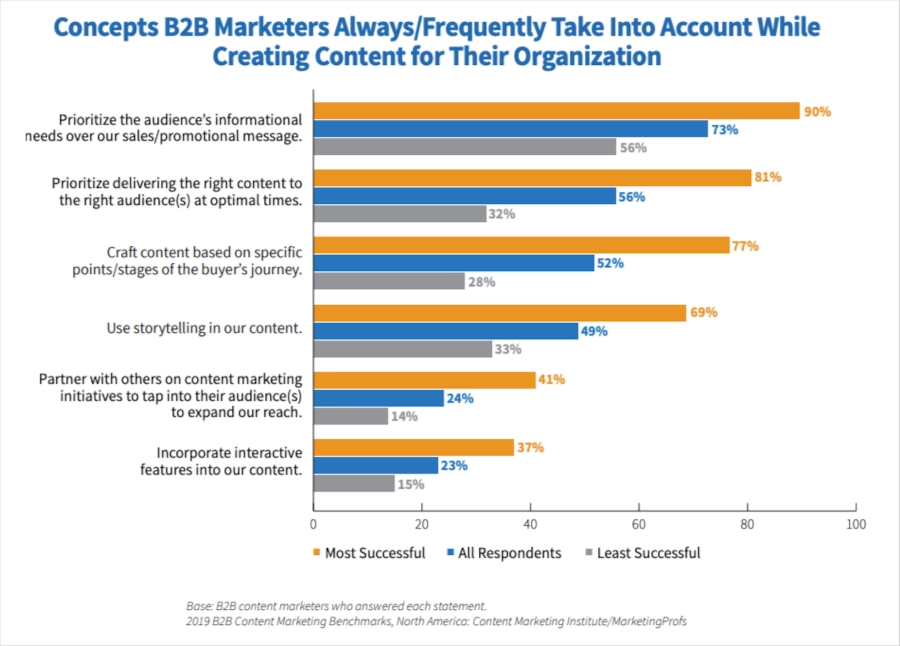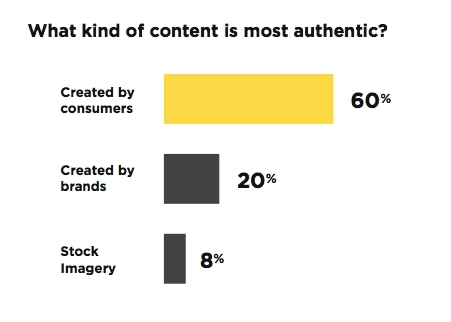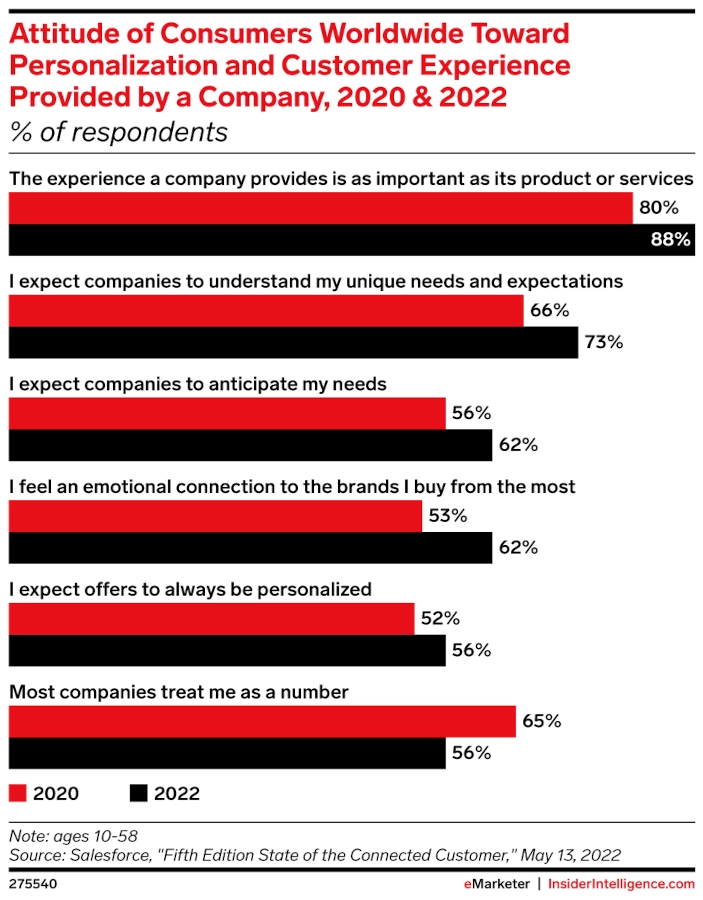Reading Time: 25 Minutes
Content marketing is the backbone of all forms of marketing and forms the core of any successful marketing strategy.
Using relevant, up-to-date, high-quality content, you can attract consumer attention, engage them, and even drive conversions.
However, the way people consume content is changing and so are content marketing trends.
As the technological landscape develops, new content marketing trends are changing how brands and marketers reach their target audiences. Only by keeping up with the changing content marketing trends can your brand stay ahead of your competition.
Let’s take a look at eleven of the most innovative content marketing trends that are shaping the future of marketing.
With the invention of virtual reality (VR) glasses, a lot has changed in the world of online marketing. Virtual reality allows the viewer to be completely immersed in the video experience, making it an attractive way for brands to engage with customers.
Brands have started incorporating the power of virtual reality into their content marketing strategies. Many tech giants like Facebook and Sony have made investments in this field already.
Even YouTube has thousands of virtual-reality-enabled videos online. Many new mobile phones, like Lenovo K8 Plus, come with VR Glass Modes.
Some brands, like StubHub, have already incorporated virtual reality into their marketing strategies.
StubHub is a ticketing app for events and concerts, which provides people with the option to see the exact view from the seats they want to book. All people need is a set of VR goggles and StubHub app and they can get a 360-degree view of their seats.
This is a brilliant example of how brands can use virtual reality and video content marketing to provide a unique customer experience.
This provides a whole lot of options for companies to do content marketing. There’s a whole new world inside the glasses and the opportunities are truly endless.
Be it virtual video advertisements, text advertisements, or even simple brand logos, you can do it all. Everything that is possible in the real world can be replicated inside this virtual world.
Just like virtual reality, augmented reality (AR) is yet another technology that has emerged recently.
In augmented reality, you can interact with computer-generated information that’s completely augmented. It gives you the feeling of interacting with objects just as in the real world.
It can even have different sensory inputs such as visual, olfactory, and auditory. It’s possible to utilize augmented reality to create content for marketing.
With endless opportunities already in the real world, you can only imagine the ones in these “realities.” Together, these innovative content marketing trends will be shaping the future of marketing.
Live videos emerged a couple of years ago, and since then they have taken social media by storm. Users can go live on Facebook and Instagram and share their videos with their friends and the world.
Videos can convey a lot more information than text or still photos. It is also a more interactive experience as compared to other types of content.
Live videos give users the chance to interact with the video creator while the video is being made. This gives a much more interactive experience to the users and makes them feel more involved.
A study by Brandlive found that 95% of marketers were planning to incorporate live videos into their marketing strategies in 2018. Also, according to Cisco, videos will constitute 82% of all online traffic by 2022.
These statistics clearly point to the growth of videos and live videos in the upcoming years.
As access to the internet around the world increases, the number of viewers and creators of live videos will also increase. This gives brands a great opportunity to utilize the power of live videos.
Using live videos, marketers can promote their brands to a large audience and generate higher engagement. The interactive nature of live videos can even improve your chances of conversions.
Brands can go live during their product launches and broadcast them over the internet in real-time. While this method has already been implemented by many brands, a lot of opportunities still remain untapped.
For example, brands could run live Q&A videos where they directly interact with their audiences. Similarly, you could sponsor live videos created by others and have your brand names displayed in it.
A great way to promote live videos can be through influencers. Influencer marketing utilizes the massive reach and engagement that certain individuals on social media are able to create.
These influencers have a loyal fan-followings that regularly engage with their content. Brands can collaborate with these influencers and ask them to promote their products through their content.
Influencer marketing has gained tremendous popularity and has already surpassed print marketing and is catching up with video marketing.
While influencer marketing already has already explored photos, videos, and text, live videos have not been explored much. If you can combine the power of influencer marketing and live video marketing, you’ll have a killer combination.
A study by Influencer Marketing Hub found that influencer marketing is the fastest growing customer acquisition method online. 28% of marketers claimed that it was the fastest.
You can team up with influencers and have them review your products in live videos. Or you can have them showcase your products in their live videos. This will garner the attention of their audiences who are likely to engage with the live videos.
Live videos from influencers have loads of advantages. While many people may watch the live broadcast, others can watch them later too. This allows you to tap into audiences who weren’t online during the live streaming.
If your influencer has created a live video with a product review, you could use it as a testimonial too. When your audience sees a testimonial from an influencer, chances of them converting are higher.
Influencer marketing is more affordable than other forms of marketing too. This can help you promote your brand and products with smaller budgets as well.
See Also: Influencer Marketing 101
One of the newest content marketing trends brands are embracing is the use of the Stories feature on social media platforms. Stories started off on Snapchat and today they are everywhere. Instagram, Facebook, WhatsApp, and Messenger – all of them have this feature.
These Stories remain online for 24-hours before they are deleted automatically. Stories can be seen by the followers or even by non-followers based on the owner’s privacy settings.
Stories give you the opportunity to add images, videos, and text. This gives brands the opportunity to change their content and experiment with new content too.
On Instagram, if you have more than 10K followers on your business account, you can add links to your Stories too. This lets you insert a direct call-to-action (CTA) for your audience.
Brands can utilize the Stories feature to build their social media presence and to market their products. Content marketing trends like Stories can also take advantage of the power of influencer marketing.
Brands can collaborate with influencers and ask them to post Stories. If they have more than 10K followers, you can even ask them to add your website link in their Stories. This way, you can get direct conversions from Stories.
Brands can also leverage sponsored Stories to promote their products. Sponsored Stories appear randomly between Stories that people are viewing. This can help brands grab more eyeballs as well.
When it comes to content marketing trends, this is probably the most important. Consumers value the authenticity and relevance of content more than ever before. Brands are realizing this and focusing more on these aspects while creating branded content.
According to research done by the Content Marketing Institute, 90% of the most successful content marketers prioritize relevance over promotions while creating content. They are successful because their audience trusts them and finds their content useful.

Despite the fact that this is one of the key content marketing trends, most brands fail to leverage authenticity and relevance.
According to a study by Stackla, 57% of consumers feel that half of branded content doesn’t resonate with them. This means that only 50% of brands are able to create useful and relevant content for their audiences.
You need to leverage this content marketing trend to stay relevant to your audience and not become obsolete. If you have been using too much promotional messaging in your content, it is time to step back and re-evaluate your content marketing strategy. You may need to seriously revamp it to leverage the latest content marketing trends.
This content marketing trend is in-line with the previous trend on the authenticity of content. User-generated content is considered more authentic than branded content as it comes directly from the users of a product rather than the company selling it.
A Stackla study confirms this fact that user-generated content is by far the most trusted type of content.

User-generated content is also the most up-to-date, keeping in line with the changing content marketing trends. Why? Because it is content created by people similar to those who consume it. This is why user-generated content is bound to stay relevant, even when all other content marketing trends change.
Marketers who leverage user-generated content understand that it can improve the credibility of their brands. They also understand that it can help future-proof their content marketing strategies.
Many brands have joined the bandwagon and are leveraging UGC in their content marketing initiatives.
Take the clothing brand, Aerie, for example. They run a simple yet impactful UGC campaign on Instagram. They encourage their users to post their pictures in Aerie clothing using the hashtag #aeriereal.
Apart from featuring the user’s content on their feed, they also provide the added incentive of donating money to charity for each such post.
Artificial intelligence and machine learning will play a more important role in the field of content marketing. With content marketing trends changing continuously, these technologies will help marketers make sense of it.
Here are a few ways AI will help improve content marketing:
AI is one of the content marketing trends that is still in a nascent stage and is yet to reach its peak. However, AI has the potential to help with all aspects of content marketing, from content planning to creation. Thus, it will be one of the most important content marketing trends of the future.
The best way of delivering content is by personalizing it. When people are greeted by their name or have their problems solved 1-on-1, they will be more satisfied.
It gives a more intimate feeling and makes the consumer feel that they are special.
According to a study by Salesforce, 88% of respondents said that the experience a company provides is as important as its products or services compared to 80% two years ago.

74% of marketers claimed that it has a strong impact. And 88% of marketers stated that their customers expected a personalized experience.
This clearly shows that consumers want personalization. However, personalization does take a lot of effort. There is a tremendous amount of data involved in it.
You need to start collecting data from your visitors, such as name, email, age, etc. Some of your visitors might share this data with you happily if you can offer them personalized content.
Once you have the data, you can start planning your lead generation campaign. You could offer them exclusive, unhindered access to your content or give them a freemium subscription.
You can have some of this data displayed on all the pages that your customers are likely to visit. The most important locations of all being, of course, the CTAs and checkout pages.
Another method is to display content that is tailored to your customer’s requirements. For example, Northeast Nursery uses this method to tailor their prices on products for their customers. This is possible for them through Coredna.
While it is still difficult to carry out a full-scale personalization, the scope for the future looks bright. We can expect many more opportunities to personalize content with future content marketing trends.
While this is not necessarily among the most recent content marketing trends, it is still a trend that is still going strong and will continue to be adopted by and increasing number of marketers.
The basic concept of a content cluster is that you select a broad industry topic and create several pieces of content related to its subtopics. The core topic should be a relevant and trending industry topic. And all of the related pieces of content should be interlinked.

The idea behind this is to provide customers with all of the information pertaining to a topic in one place. It also makes it easier for them to find relevant content on your website. And it encourages people to read more of your content and improves customer engagement.
And if that’s not enough incentive for you to leverage this content marketing trend, it also helps you rank better on search engines. If you write several pieces of high-quality content on a topic, Google is more likely to show your page over others that have only covered one aspect of the topic through one content piece.
As the content in every niche on the internet gets saturated, the need for new niches arises. You need to go deeper into your niche, and create content that’s more specific.
For example, if you have a food business, you need to focus on sub-niches like gluten-free food or organic food. You can dig as deep as you want and build multiple sub-niches.
To create more unique content, marketers have to either create in-depth content or focus on sub-niches. As the former is a more time-consuming and expensive process, marketers are choosing to go with the latter.
The advantage of sub-niches is that the audience for them is smaller. This means that you can personalize your content more to fit their requirements.
To do this effectively, you can start off by finding sub-niches that don’t have enough content. Once these sub-niches have been identified, you can start creating content related to them.
Consumers of today want to have real and authentic conversations. To achieve this goal, brands have two options – have a dedicated staff or use advanced tools.
Recently, chatbots have started helping brands have conversations with their customers. These bots are advantageous for the users too. They provide nearly all the services that new apps or websites provide without having to open them.
With advanced technologies like AI, chatbots are getting smarter as well. They are able to cater to the requirements of customers in a more personalized manner, and even more effectively.
Even when users require something very specific, bots are able to go through the data, find the answer, and convey it quickly.

From these interactions, you can collect data to find out more information about your customers’ requirements. Using this information, you can improve your chatbot capabilities.
Efficient chatbots can help improve your brand’s reputation among consumers too. You can even give your bots their own personality.
This way, they can even have quirky human touches despite being a bot. This can create a memorable experience for your customers who interact with it.
If you can successfully create chatbots that provide good content and more personalized experiences, you will certainly benefit. These benefits can be in the form of higher engagement of customers with your brand and even the bots.
If they can provide reliable information quickly, they can even help drive sales and conversions. Those customers who may have liked their interaction with the bots may come back repeatedly as well.
A study by Upscope on a company called Anymail Finder had some interesting results. It found that about 60% of their revenue was coming from chatbots.
Also, one out of every three buyers used the chat system before the purchase. And nine out of ten bigger buyers used the system before the purchase.
Such content marketing trends show that chatbots can help drive sales and shape the future of marketing.
Consumers today are more aware than ever of the tactics of advertising. And most consumers prefer to deal with companies that are transparent.
However, until now, very few have managed to be completely transparent with their customers. The old methods of advertising which worked in the past may not work anymore.
When brands are too heavy on marketing, many customers feel that they are not completely honest with them. This can lead to a loss of trust in the minds of the customers.
To avoid this, brands need to be more transparent with their audiences and be more authentic. You need to create a relationship of trust between your brand and your customers to achieve success in the future.
You need to make sure that all of your content is fully transparent. It could include disclosing your partners, giving due credit to others, etc.
You must also ask your influencers to flag their posts as “sponsored” when they are promoting your products. This way, you can gain the support and trust of your customers too.
You should even keep this in mind when collecting user data and storing it. Customers are aware that brands collect their data.
A study by Truste/NCSA showed that 92% of consumers were worried about their data security. With new regulations like General Data Protection Regulation (GDPR) being introduced to protect consumer data, you need to tread carefully.
This way, brands will even need to ask for permission to use consumer data and even show how they use it. If you can be transparent in this regard as well, consumers will trust your brand even more.
Current content marketing trends give us an idea of what the future holds for digital marketing. As the quantity of content on the internet increases every day, we see a greater diversification in the types of content created and how that content is used.
With technological advancements, content will become more easily accessible and even more important. Content is the core of marketing, and as content marketing trends evolve, they will shape the future of marketing.
Our team keeps a finger on the pulse, so you’re always working with the latest information.